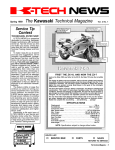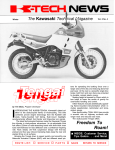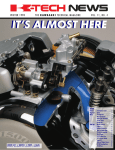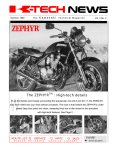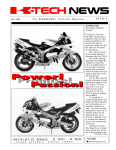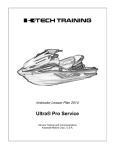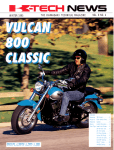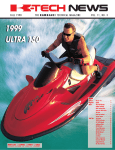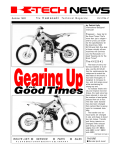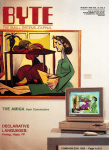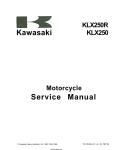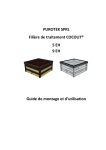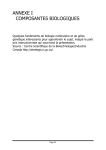Download K-Tech News Vol.2 No.3
Transcript
Fall 1989 Magazine The Kawasaki Tech sive curve. As in ’89, the Uni-Trak features an unstepped preload adjuster, 16-way compression damping, and 16-way rebound damping. An extremely rigid aluminum swingarm of thin wall dual-box-section construction offers increased rigidity with no weight penalty. New recessed, one-piece chain adjusters locate the rear axle securely. Disc brakes are standard front and rear. A dual-piston front caliper provides excellent stopping power. To minimize unsprung weight, front and rear brake pistons are made of resin while the rear brake rotor is now made of stainless steel. The KX250 bodywork gives the rider plenty of freedom to move comfortably. The fuel tank is slimmer, and the new side cover/number plate mounts flush, making the bike even narrower in the mid-section. o by Tim Bean, Program Developer HE BIGGEST NEWS IN MOTOCROSS this year will be Kawasaki’s perimeter frame, a first in production motocross bike history. This innovative frame design has several advantages: stronger steering head, stronger swingarm pivots, better mass-centralization and greater overall rigidity. Combined with a new swingarm modified to increase rigidity, the perimeter frame-equipped KX250-H1 exhibits superb stability on rough tracks. The mainframe is constructed of lightweight high-tensile steel with a bolt-on aluminum rear section, and an aluminum steering stem to reduce weight. The KX250 is fitted with a 41mm Kayaba cartridge fork (see Jerry Heil’s article on page 2 of this issue). The cartridge design gives more constant damping force regardless of stroke speed, with the smoothest possible initial compliance. The fork features 16-way compression and 16-way rebound damping. T ROUTE LIST o SERVICE o PARTS Vol. 2 NO. 3 n INSIDE: Happy Customers, Inverted Forks and More! o SALES RETURN TO SERVICE SHOP TALK/TECHNICAL Inverted Forks On 1990 KX125/250/500 by J. Heil, Instructional Designer HE INVERTED FORK featured on Kawasaki’s latest KX125, 250 and 500 models is another significant advance in reducing unsprung weight. The steel inner tube of the inverted fork is shorter and smaller in diameter, and, therefore, the whole assembly is lighter than conventional forks. Reduced weight permits the suspension to move more freely, responding more quickly to changes in terrain. The large diameter aluminum outer tube held in the triple clamps is a thick-walled casting. This rigid construction gives the inverted fork-equipped motorcycles extremely precise steering control. T The mechanics of compression damping is as follows: as the front tire strikes a bump, the fork inner tube and attached cartridge are pushed up. The size of the chamber below the cartridge piston decreases and the chamber above the cartridge piston increases. Oil passes out of the lower chamber, through the check valve on the piston and into the upper chamber of Component Parts While the appearance of the fork is at first unusual, the parts that make up the assembly are nearly the same as conventional forks. The accompanying illustration shows the components that are available as spare parts. The new KX cartridge fork started with a design objective similar to other Kawasaki cartridge front forks to reduce the amount of air in the fork oil. Air mixed with the oil makes damping erratic. To prevent this, oil enters at the bottom of the cartridge only after any air inside has risen to the top of the fork. The damping action remains predictable, even on the toughest tracks. Compression Damping compression and Rebound damping on the inverted forks are both 16-way adjustable. Turning the adjustment screws varies the amount of oil bypassing the damping valves. The suspension can thus be adjusted to suit both rider style and track conditions. 2 l K-Tech News KX Inverted Fork Components the cartridge. Damping at the check valve is fixed. The oil flow rate is progressively damped by the compression washer stack as oil moves out the bottom of the cartridge into the inner tube. The amount of oil bypassing the washer stack depends on the setting of the adjustable valve. Rebound Damping As for rebound damping, when the tire and wheel move down, the inner tube and cartridge move away from the piston. The size of the chamber above the cartridge piston decreases and the chamber below increases. Oil flow is redirected by the check valve out of the upper chamber through the rebound washer stack. The rebound adjuster valve permits some oil to bypass the washers and flow up and out the top of the piston rod. Maintenance All forks require the proper oil and springing to tune the suspension to the track and rider; the new inverted fork is no exception. A suspension set-up chart will soon be available from Team Green to help with this. Clean, fresh oil is essential to proper fork operation. Team Green suggests changing the fork oil after every two to three hours of hard riding. Fill the fork with oil to a level above the desired height. Pump the piston rod and outer tube 10 times each to remove all the air. The piston rod should pull up the entire length of its stroke with uniform resistance. Jerks or “gurgling” noises indicate that air remains in the fork. Pump a few more times. When all the air is removed, set the fork oil level according to the service manual. NOTE: If you need to hold the fork in a vise, be sure to grip the fork outer tube gently so you do not distort the aluminum. This can happen, so be careful! Fork Air Pressure The center screw on the fork cap is the rebound damping adjustment. The other screw is the air bleed. Proper air pressure is zero. Set the pressure by first riding the bike for 10 minutes. Then, with no weight on the bike, first open the air bleed screw on both forks then close them. Watch for additional info on these inverted forks, which are standard on ’90 KX125s, 250s and 500s, in the months to come. o COMMUNICATIONS Service Manual Corrections On page 5-11, the Clutch Spring Height Measurement table should look like this: by Ray St. John, Senior Technical Writer ENTER THESE CORRECTIONS in your shop’s service manuals, and be miles ahead of the game... Clutch Spring Height n VULCAN 88/SE (P/N 99924-1078-01): On page 1-8, Standard: Service Limit: the torque table for the engine lubrication system should look like this: Engine Lubrication System: Crankcase Oil Nozzle Oil Pressure Relief Valve Oil Pressure Switch Engine Drain Plug Oil Filter Oil Screen Plug Oil Pipe Banjo Bolts 2.9 20 15 0.30 2.0 1.5 26 in-lb 14.5 11.0 12 1.2 104 in-lb n ZX-10 (P/N 99924-1098-01) KLR250 (P/N 99924-1051-01 and -02): Add the following information to the “Fuel Tank” section: Gasoline and Alcohol Blends Blends of gasoline and alcohoI called “gasohol” can be used on an occasional basis, however continued use is not recommended. Switch back immediately to gasoline which doer not contain alcohol if you experience any operating irregularities. Any deterioration of fuel system components or degradation of performance resulting from the use of gasohol will not be covered by Kawasaki’s Limited Warranty, Emissions Warranties, or Good Timer Protection Plan. If you decide to use gasohol. be sure to follow these simple cautions: ¡ Never use gasohol with an octane rating lower than the minimum octane rating specified by Kawasaki for this product. ¡ Never use gasohol containing more than 10% ethanol (grain alcohol). ¡ Never use gasohol containing more than 5% methanol (wood alcohol). Gasoline containing methanol must also be blended with cosolvents and corrosion inhibitors. ¡ Never use gasohol for extended periods and never store this product with gasohol in the fuel system. ¡ Gasoline containing alcohol can cause paint damage. Be extra careful not to spill gasohol during refueling. MICROby “Micro” Mike Jeffers, Parts Publications Specialist OST 1990 MODEL MICROFICHE have been M delivered and should now be nestled in the appropriate spots in your immaculately kept microfiche decks. The white section (“Other Products”) now includes JET SKI® watercraft, JET MATE™, Mule and Trailer microfiche. Your microfiche deck will contain microfiche matching the products you carry. To fully capitalize upon the many benefits the microfiche parts system offers, periodic maintenance to the equipment is required. The interior of the viewer must be dusted and the mirror wiped clear of any accumulated dirt at regular intervals. Do this by removing the blue screen: Hold the tab at the bottom, then lift up On page 8-2, correct the torque marks as shown at right: n KDX200-C1 Owner’s/Service Manual (P/N 999201323-01): On page 94, the table of stator coil resistances is correct only if the stator has five leads. If the stator has only four leads, use the stator resistance table found on page 9-4 of the KDX200-C2 Owner's/Service Manual (P/N 99920-1371-01). n ZG1000 Concours (P/N 99924-1065-01): Engine oil capacities should be as follows: - Totally dry engine, oil cooler, and lines: 3.7 liters - Normal oil change with new filter: 3.0 liters - Normal oil change without new filter: 2.7 liters n EX250E/F NINJA and EL250A ELIMINATOR (P/N 99924-1066-01): In these manuals, the top and second piston rings are described as being different, but they are actually the same. Another correction is needed on page 4-22: Just note that the second ring is the same as the first. The specifications on page 4-5 are correct. o and pull the bottom of the screen towards you. The screen will then lift clear of the viewer. The lens must also be dusted periodically. It can be removed by swiveling the lens hood then lifting it out of its holder. After wiping it clean, reinstall by aligning the tab on the side of the lens with the matching slot on the holder. The microfiche holder itself is cleaned by positioning it to the far right and lifting the upper glass clear. To reinstall, reverse the procedure. Kawasaki offers a maintenance kit (P/N M99994151) and supplies bulbs for all viewers including the older Bell & Howell/MDI viewers. A complete list of microfiche viewers and accessories offered is found on parts bulletin GEN 89-02. Equipment is ordered directly through your distribution center by using the part numbers provided. o The Technical Magazine 3 l GUEST SPOT Kawasaki Endorses Motorcycle Mechanics Institute ET US ALL WELCOME the Motorcycle Mechanics Institute into the Kawasaki family. Kawasaki Motors Corp., U.S.A. has endorsed the training program at MMI because it is one of the finest motorcycle does a first-rate job of maintaining this supply. Its courses prepare students to work in and contribute to the profitability of a dealership while gaining the on-the-job experience it takes to become seasoned journeymen. In less than 12 years, the Motorcycle Mechanics Institute has grown from a small, regional training center into the nation’s largest technician training schools in the country. To enhance MMl’s training offerings, we are now providing technical information on Kawasaki products which will be incorporated into its classes. We all know that the vitality of the motorcycle industry depends on a supply of well-trained, career oriented students who can fill the demand for entry level technicians. The Motorcycle Mechanics Institute motorcycle technician training institute. With state-of-the-art facilities in both Phoenix, Arizona and Orlando, Florida, the Institute each year enrolls more than 1,700 men and women who are interested in pursuing careers in the fast-paced ‘motorcycle industry. To develop a general understanding of today’s motorcycles and to qualify for entry level employment as motorcycle tech- by Don Church, Manager, Service Training & Communications L ©1989 Kawasaki Motors Corp., U.S.A. (KMC). All rights reserved. Published by Kawasaki. All suggestions become the property of KMC. Sending a service suggestion gives Kawasaki permission to publish and/or use it without further consideration. Specifications subject to change without notice. 4 l K-Tech News nicians, students at MMI begin their training with a six-month Motorcycle Technician Career Program. Like all courses at MMI, the career program is “hands on”, permitting students to immediately put their new-found skills to work in areas such as carburetion and fuel systems, electrical systems, transmissions, suspensions and troubleshooting. The Advanced Career Program, meanwhile, is a highly intensive three-month course which provides students with advanced skills in several areas: two-stroke performance, four-stroke performance, advanced machine shop, advanced electrical systems, specialized equipment (JET SKI® watercraft and snowmobiles), and shop management. Look for representatives from MMI at the Dealer Meeting in Miami Beach, Florida, and find out more about it. The Institute has a very organized and active student placement office for matching its students with dealers all over the country. For those not at the Dealer Meeting, MMI can be contacted by writing or calling: n Motorcycle Mechanics Institute, 2844 West Deer Valley Road, Phoenix, AZ 85027, (602) 8699644 or (800) 528-7995 n Motorcycle Mechanics Institute, 4065 L.B. McLeod Road, Suite A, Orlando, FL 32811, (305) 4231514, (800) 342-9253 o K-TECH NEWS STAFF Publisher ....... Kawasaki Tech Services Publications Manager ........ Don Church Executive Editor.. ............. Gary Herzog Editor-in-Chief.. ................. Ken Ploeser TECH SUPPORT SPECIALISTS Bob Ellison Joe Nowocinski Randy Davis Tevis Moffett John Porno Ken Osberg Gregg Thompson Steve Rice REGIONAL EDITORS North and East . . . . . . . . . . . . . . . . . . Fred DeHart Central and South . . . . . Walter Rainwater West and Corporate . . . . . . . . . . Ken Ploeser GRAPHICS AND PRODUCTION Graphic Art . . . . . . . . . . . . . . . . . . . . . . . . . . .Tim Bean Copy Editor . . . . . . . . . . . . . . . . . . . . . . . . . Pat Shibata Production....Nickless Communications FEATURE Keeping Satisfied Customers by Ken Ploeser, Tech. Services HINK OF HOW MANY customers have walked through your dealership in the last 10 months. From the hundreds or even thousands of those people, surely many left as satisfied, paying customers. But how many of them soon forgot just how helpful you were the last time they stopped in? How many liked the service you gave but don’t have any special reason to return to the dealership? T The point: It’s your job to give them a special reason to return, or they may never return at all! Follow-Up How do you keep customers excited about their Kawasakis and coming back regularly to your dealership? One way is to keep them informed. Remember the old saying, “out of sight, out of mind”? Well, that’s exactly what happens when you don’t focus your efforts on communicating with customers. It’s called “follow-up” and the first building blocks in creating an effective customer follow-up program are your service records. Now is the time to gather together all records of service transactions with consumers. Retail work and warranty claims reflect a majority of your service customers to date. From these repair orders you can pull up a list of all the periodic maintenance jobs performed. Especially important are the first services and subsequent periodic services performed over a period of time for the same customer. Also, pull up repair orders that reflect work performed for customers on the Good Times Protection Plan. By categorizing the repair orders you will have groups of customers to contact. If your service department is automated, the task of “pulling up” customer records is relatively easy. For those of you whose shops do not yet have service customers and repair orders on computer, we have a simple solution: Since you do have a K-SHARE computer, you have the capabilities to record There are two approaches. One is to deal with only those customers who are service customers. A few ideas: Offer winterizing and storage specials. Offer discounts on the additional work suggested on the repair orders that was never done. Hold an open house for service after renovating or remodeling the service shop. During the summer you can have customers fill out “customer cards” for future mailings. From these cards you can solicit service work. your repair orders on computer. Once this is done, you can print out reports that will show you some interesting things. One advantage is the customer letters and mailing lists you can generate. The software program that allows you to do all this is called PFS: First Choice. It is available from most computer software stores. (For more information on PFS: First Choice software, please contact Marge Lakin, KMC’s KSHARE manager, at (714) 7700400 ext. 2345. She will give you all the help you’ll need to get started on your computer.) The second approach is to combine the service customer lists with parts and sales customer lists. In this way a tie-in can be made to service. For example, any parts specials or close outs can be offered with installation. KX race kits can be offered through “Team Green” specials. Schedule a special week for KX bike services. And what about all those JET SKI® watercraft out there?! Of all the new JET SKI® watercraft sold over the spring and summer, how many are due for service? Offer a special to IJSBA members on accessories and hop-up services. Every person who bought a new or used vehicle from your dealership should be contacted in some way-perhaps with a survey of all customers which will remind them of the good times they have experienced with their Kawasaki and let them know you are inviting them to visit the dealership soon. Keeping in touch with your customers during the slow times will be the key to a good winter and a great spring selling season. o Now What? Customers that bought at your dealership, returned for periodic maintenance and are on the Good Times Protection Plan, form a solid base for a customer follow-up mailer. So, now what do you do? What can you put in a service mailer to stimulate customer awareness of your existence during the cold, wet months of winter? The Technical Magazine 5 l SERVICE/MERCHANDlSING ® JET SKI Watercraft Winter Service by Fred DeHart, Training Instructor North and East Regions OW IS THE TIME for service departments in the North and East to think about JET SKI ® watercraft winterization as a way of generating additional service income and assuring their customers satisfaction in the spring. Get out your customer service file and send each JET SKI ® watercraft owner a letter explaining how and why his boat should be winterized. Offer a special combined storage and winterization package (or, if you really don’t have the space, offer winterization only). Be sure these jobs ‘are scheduled for a time when your fall workload is slowing down. N manuals and service bulletins if you are not familiar with this procedure. n Drain the gas from the tank and leave the cap loose to prevent condensation. n Drain the fuel sediment bowl and clean or replace the filter. n Start the engine and run it at 15 second intervals, allowing five minutes to cool between intervals. Do this until all available fuel in the carburetor is used up. n Another method is to add Sta-Bil fuel stabilizer to the gas before draining and then run it through the engine. Customer Approval Now that you have contacted all your past customers, what should be done to winterize their JET SKI@ watercraft? First, inspect the boat for any major problems, cosmetic, technical or especially safety related. Note the items you feel need attention on the repair order and make sure the customer is aware of all the items you find. Next, review these with the customer, and get proper. approval before proceeding with the job. Consider taking a photo of the watercraft before work is done to verify its before condition. A Winterization Primer Here are the basics of winterization program: a n Flush out the cooling and bilge systems. 6 l Consult the proper K-Tech News n Take out the flame arrestor and clean it. Spray Bel-Ray 6-in-1 or WD-40 down the carburetor bore. Inspect the flame arrestor carefully; you may want to install a new one. n Remove the spark plugs and pour about an ounce of motor oil into each cylinder. Don’t use too much or you will damage the engine when it is next started. Leaving the, plugs out, turn the engine over with the starter to coat the piston, piston rings, and cylinder with oil. Replace the spark plugs. n Remove the exhaust resonator and pour three ounces of antifreeze into the muffler box to prevent any residual water left in the box from freezing. If the water box has never been flushed out, this may be a good opportunity to do it now. Replace the resonator. n Remove the battery and clean the outside surfaces with a baking soda and water solution. Check the battery electrolyte level and refill with distilled water if necessary. Fully charge the battery and store it in as cool a location as possible to keep it from losing its charge. A fully charged battery will not freeze until -76” Fahrenheit. n If the watercraft has grease fittings for the forward bearing housing and pump housing, fill them with a waterproof marine grease. n Lube all cables front and rear. n Spray WD-40 or Bel-Ray 6-in-1 into the magneto housing to prevent rust from condensation. n Check the pump housing and impeller for wear or damage, and clean out any sand, weeds, etc. This is a good time to do a complete pump bearing inspection and service. n Wash the watercraft inside and out, then drain all water from the engine compartment by turning the watercraft on its left side and dry it off. n Spray the engine and metal parts with WD-40 or Bel-Ray 6-in-1. ® n Wax the outside of the JET SKI watercraft. n Cover and store the boat in a clean, dry place with the hood blocked up to provide ventilation and prevent distorting the strap. Ready For Fun! If proper winterization is accomplished now, the JET SKI ® watercraft will be ready to provide lots of fun and good times for your customer in the spring. o TIPS FROM THE SPECIALISTS Finding Those Amps 4 x 4 Tie Rod Adjustment by Tim Bean, Program Developer O PREVENT INTERFERENCE between tie rod ends when the steering is O SAFELY AND accurately T turned to full lock, the repair procedure below should be followed. The T measure the charging system’s ball joints that connect to the wheel end of the tie rods must be screwed all output in amperage, you will need to install an ammeter in series at the ground side of the battery. But wait: If you electric start the engine, you will fry your meter unless it measures up to 250 amps. So, make a jumper cable that connects across your ammeter probes while cranking the engine over. Once the engine fires, disconnect this jumper wire, leaving the ammeter connected in series with the battery and the ground strap. Next, rev the engine until the meter indicates a charging amperage higher than the loads on the system. This is called the “break-even rpm.” Obviously, higher loads require higher rpm to break even. Now you can measure the individual loads (amperage draw) on the system. To do this, simply reverse the connections (polarity) of your ammeter probes. Then, with the engine off, turn on the stop light, horn, turn signals and any accessories. Write down the readings and then add up the total amp draw on the system. Police bikes and touring bikes seem to suffer most from excessive. loads on the battery. Be sure to check for shorts or excessive amp draw from every electrical accessory, since it may be impossible for a charging system to handle excessive current loads. - Tevis Moffett the way flush with the end of the tie rod. This allows the ball joints at the inner end of the tie rod to be adjusted out further. Some KLF300’s have short tie rods which must be replaced. Refer to Recall Bulletin MC89-04. The “repair procedure” described in the bulletin should be followed when adjusting the steering tie rods on any KLF300 model even if it is not eligible for the recall. The procedure is as follows: Repair Procedure n Remove the tie rod assemblies with the ball joints by removing the cotter pin and mounting nut from each ball joint. n Place each tie rod and ball joint assembly on a large piece of paper. Mark the center of each ball joint and make a corresponding mark on the paper to record the original length of the right and left tie rod assemblies. This will prevent having to make toe-in adjustments after installing the new tie rods. n Loosen the locknuts and remove the ball joints from the tie rods. n Screw the wheel ball joint into the tie rod end closest to the crimp, and tighten the ball joint locknut to 2.8 kg-m (20 ft-lb, 27 N-m) of torque. n Screw the ball joint of the steering shaft into the other end of the tie rod by turning clockwise 7 rotations. NOTE: Steeringshaft ball joints have light colored locknuts. n Set the ball joint studs of each tie rod to face opposite directions. n Position the tie rod assembly beside the marks that were placed on the paper. Screw only the steering shaft ball joint in or out to align with the marks on the paper to obtain the original length. n The difference between the original length and the new tie rod length must be within 1 mm. n Torque the remaining ball joint locknuts, to 2.8 kg-m (20 ft-lb, 27 N-m). n Install each tie rod assembly with the fully screwed in ball joint connected to the wheel steering knuckle. CAUTION! If the direction is reversed, the two tie rod assemblies will interfere with each other when the handlebar is fully turned to the right. n Tighten the mounting nut to the specified torque: BaII Joint Mounting Nut Torque =4.2 kg-m (30 ft-lb, 41 N-m) n Install new cotter pins. o The Technical Magazine 7 l TIPS FROM THE SPECIALISTS JET SKI® Watercraft Carb Tuning Chart Voyager Computer Memory UEL CONSUMED MODE: F Here is the procedure you follow to set the total fuel consumed USE THE FOLLOWING carburetor needle adjustment specifications when tuning 1988, ’89 and ’90 model JET SKI ® watercraft: number on the Voyager computer. Start out with a full tank. Turn the ignition key on. The fuel gauge display on the meter console will light all the bars, showing a full tank. Next, move the cursor to the “Total Fuel Consumed” mode on the computer display. It will show 6.6 gallons in this mode. Push the fuel button once and hold it until the reading shows 0.0 (zero). Then the total fuel consumed will show in increments of 0.2 until the 6.6 gallons is consumed. MODEL ITEM JS300A Lo Speed Screw Hi Speed Screw Lo Speed Screw Hi Speed Screw Lo Speed Screw Hi Speed Screw Lo Speed Screw Hi Speed Screw Lo Speed Screw Hi Speed Screw Lo Speed Screw Hi Speed Screw Lo Speed Screw Hi Speed Screw Lo Speed Screw Hi Speed Screw Lo Speed Screw Hi Speed Screw ADDING FUEL DURING A TRIP: To add, for example, one gallon of fuel, you move the cursor to the “Fuel Add” mode. NOTE: Every time the fuel button is pushed, 0.2 gallons is added to the display. Push the fuel button until 1.0 gallon total shows. Move the cursor to the “Total Fuel Consumed” mode and the added amount is automatically entered into the computer memory. The “Fuel Add” mode will only accept up to 2.0 gallons at one time. To add more than 2.0 gallons, the cursor will have to be rotated around to the “Fuel Add” mode again and the remaining amount added. - Tevis Moffett JS300B JS440A JS550A JS550B JB650A JF650A JF650B JS650A 1988 1 11/16 3/8 1 3/4 1 3/8 1 3/4 1 1/16 15/16 ————1 1/8 5/8 ——1 1/8 5/8 1989 1990 1 15/16 15/16 1 3/4 1 3/8 1 3/4 1 1/16 15/16 ——1 1/2 1/2 1 1/8 5/8 1 1/8 3/4 1 1/8 5/8 1 15/16 15/16 1 3/4 1 3/8 7/8 3/4 n/a n/a 1 1/16 15/16 1 1/8 3/8 1 1/8 3/4 1 1/8 3/4 1 1/8 3/4 NOTE: The tuning specifications for the 650 models are based on the following standard jet sizes: ’88-’89 1990 1989 1990 JS650-A JS650-A JB650-A JB650-A slow slow slow slow jet jet jet jet #48 #52 #55 #58 Troubleshooting Pick-Up Coils S OME HARD TO FIND symptoms of a bad pick-up coil are poor gas mileage or sluggish acceleration. To test the pick-up coil you should first check the resistance as indicated in the appropriate service manual. The next step is to check the AC voltage output from each pick-up coil. The trick is to probe the pick-up coil connector terminals while the bike is running. The reading you get will be in AC voltage. The amount will depend on the model and the rpm; the reading at idle should be about 0.5V AC and about 2.0V AC at 8 K-Tech News l 4000rpm. Record these AC output specs and compare them to the specs you got from testing good pick-ups on identical model bikes. On bikes with two pick-ups, the most critical part of the test is the consistency in readings between the two pick up coils. The voltage readings should be within 10 percent of each other. If you don’t have spark, the likelihood of a bad pick-up coil is greater than a secondary coil or igniter failure. - Tevis Moffett TS Fuel Tap Installation going to the fuel valve on early TS model T watercraft (prior to hull #96450) may Pitch, Pins or Links HE FUEL HOSES be mismarked, making it possible to install the hoses on the wrong spigot of the fuel valve. Refer to the following illustration when installing the hoses and don’t be confused! - Ken Ploeser O NE METHOD for checking various kinds of chains for wear and stretch is to load the chain and measure its length. The listed in length specification Kawasaki. service manuals is the chain length measured from center of pin to center of pin. The way you count the pins is the key to obtaining the correct measurement. Cruise Control Tips HIGH PERCENTAGE of cruise control problems are nothing more than A the result of one of the “set” switches being open. All the set switches must be closed in order for the system to set. These switches are: the front and rear brake lever switches, the clutch lever switch and the throttle switch. NOTE: These lever switches are separate switches unique to the cruise circuits; they are not the brake light or clutch (ignition) interlock switches. Test the continuity of the switches with the control unit unplugged and the transmission in high gear. Connect one lead of your ohmmeter to chassis ground, the other lead to the #16 pin on the control unit harness connector. Your reading should show continuity to ground-a reading of zero ohms resistance through the set switches. Operate the switches and check the continuity. With the lever pulled in (clutch or brake), the resistance should show open, i.e. infinite resistance. Be careful not to distort the female terminals in the connector or you may create a new open circuit problem. - Randy Davis Drive chain pins are counted out starting with the first pin as number one and continuing to the 21st pin. Cam chains, however, are counted out starting with the first pin as number zero. The next (second) pin is thus number one and so on to pin number 20. In either case, the chain pitch (the distance between pin centers) is being measured. So, 21 pins equals 20 links. EX500 Won’t Rev? OU’VE FINISHED the tune-up on your customer’s EX500. Y It starts and idles just fine. Now it’s time for the test ride. Helmet on, you fire up the bike, put it in gear and go. Suddenly, at 3500rpm a bad hesitation is present and getting worse. More revs and the hesitation turns into “blubbering” and an engine that will not rev at all past about 5000rpm. What’s wrong? The likely cause is the carburetor float vent tube aiming into the air inlet on the rear of the air box. When servicing the air filter, it is very easy to dislocate this tube. Often the tube ends up right at the air box inlet. The higher you rev the engine the more vacuum is created at the air inlet. This vacuum is actually pulling the air out of the float bowls and starving the engine of fuel! - Steve Rice CHAIN LENGTH MEASUREMENT Confused? A “link” is also called a side plate. Both terms are commonly used to describe the length of a chain. A chain length always has two fewer pins and one less side plate than you count for determining its length. Where is the missing link? It’s the master link, of course! (The real challenge is to find the master link on an endless chain...) - Randy Davis The Technical Magazine 9 l TIPS FROM THE SPECIALISTS Briefly. . . n OIL LEAKS ARE EASY to locate and pinpoint by using the following technique: Clean the suspected area thoroughly with a spray washer. Then, carefully clean the engine surface with lacquer thinner (a residue-free solvent). Let the area dry and spray on a dry powder such as Arid dry spray or Desenex powder. Pinch off the crankcase breather tube and start the engine. Any leak will show up right away, saving lots of time and frustration. - Tevis Moffett n ONE ITEM NOT FOUND in the Vacuum/Pressure tool kit (P/N T96000-001) is the adjustable rubber freeze plug. These are used to plug off intake or exhaust passages quickly, without fabricating block off plates or using inner tube rubber. Rubber freeze plugs can be found in most auto parts stores in sizes to fit almost any application. Prices are usually under $5. - John Pomo Trickle Charger Timer N TOURING MODELS, the clock, memory circuit, and comO puter all drain the battery while the bike is parked. Two weeks may be enough time to cause a good but older battery to go dead and new batteries may sulfate from a low current drain on them while the bike is parked for extended periods. We all know that a trickle n OCCASIONALLY WE ASK you to take pictures of damage, cracks or paint flaws on JET SKI@ watercraft hulls. This works very well if you prepare the surface first so the cracks show clearly on the photo. Use charcoal or pencil-lead powder to rub over the area, then blow off the excess. The camera and film should both be high quality. If your pictures do not clearly show the problem, it will hamper our ability to make a decision and maybe the processing of your claim. - Gregg Thompson n THE CORRECT tire pressure for the ZX750-H1 front tire is 36 psi, and for the rear it is 41 psi. Please update your Assembly and Preparation manual (P/N 99931-1229-01), page 10, to reflect the correct specs. - Ken Ploeser n CONTINUOUS USE of a generator under verylight loading is typical. So is the fact that many generators are not maintained properly by the user. A generator may lose power or not rev up even though there is no mechanical or electrical failure. Often the cause is a heavy carbon build up in the spark arrestor and combustion chamber. First, check the spark arrestor for signs of excessive carbon build up at the exhaust outlet. Then check the compression. If carbon deposits are evident or the compression reading is high, a simple decarboning job should cure the problem. - Bob Ellison n A NEW CYLINDER HEAD is used on the KX125-G1, starting with engine #008802. The new head, P/N 11001-1308, has a combustion chamber volume of 4.19cc, reduced from 4.67cc on the original head. The increase in compression will yield increased performance output. Be sure the fuel (race gas) being used is fresh and that the oil mix ratio is according to factory specs. - Ken Ploeser n A BEEFED UP OIL TANK CAP for the TS watercraft is now available. The original cap had a tendency to crack if tightened with excessive force. The new part replaces the original one even if you order the old part number. The new number is 16115-3709. Refer to service bulletin JS89-04 for warranty claim information. - Ken Ploeser 10 l K-Tech News charger is the answer to this problem. Kawasaki offers a Yuasa trickle charger in the accessories catalog (P/N K56019-005 for 12 volt systems). The tip is to advise your customer to plug the charger into a lamp timer available at most hardware or home improvement stores. Just set the timer to go on daily for three to five hours to avoid prolonged use of the trickle charger. Overcharging may eventually weaken the battery. - Tevis Moffett Consumer Service Tips OMETIMES A PART necessary to fix a unit is on back order. You have checked with your local distribution center, but the information you have been given isn't satisfactory or isn't specific enough for your customers. Consumer Services can help in determining back- S No LOCTITE® On Plastics! LTHOUGH THE LOCTITE Company recommends that A their many types of thread-locking agents not be used on any plastics, someone occasionally forgets and ends up with a badly damaged plastic component. LOCTITE® will attack and deteriorate any plastics on any Kawasaki product; it is known to cause immediate and unrepairable cracking, crazing and softening of plastic. Please think of LOCTlTE® and plastic the way you do brake fluid and paint-keep them away from each other! - Keith Pestotnik KX Carb Tool O COMPLETELY disassemble T the carburetors on KX125,250 and 500 models, you will need a special socket available from SnapOn tools. It is the #T120 Tamperproof Torx bit with a hole in the end to accommodate the special tamper-proof screw head design. The aluminum center block, inside the float bowl, contains the main and pilot jet system. This block must be removed and inspected before you dip the carb in cleaner. Do not submerge the rubber O-rings in carb cleaner; these are not available as replacement - Fred DeHart parts! order status. However, if you need to refer customers to us for parts information, it is essential that you give them the model designation of their product and the correct part number for the part(s) in question. Given the model and parts numbers, we in Consumer Services can quickly research the situation and provide the service necessary to help keep your customer satisfied. - Mary Sola Using ZX750-H1 Special Tools by Ken Ploeser EW SPECIAL TOOLS exclusive to the N ZX750-H1 have been developed and are available now. These include a fork cylinder holder (P/N 57001-1297) and a fork piston rod puller (P/N 57001-1298). The fork cylinder holder is used to remove and install the front fork cylinder using the following procedure: P/N 57001-1297 FORK CYLINDER HOLDER Œ Remove the cap assembly from each fork tube top, then remove the spring and pour out the fork oil. • Clamp the fork outer tube in a vise but be extremely careful not to damage or distort the tube in any way. Ž Put the fork cylinder holder into the inner tube with its square end inward so that ‘it fits into the CYLINDER HOLDER CYLINDER square recess in the cylinder top. • While stopping the cylinder from turning with the holder, remove the Allen bolt from the tube bottom, then remove the cylinder. THE PISTON ROD PULLER, meanwhile, is used to bleed the air from the fork oil and to install the cap assembly on the fork tube top. The procedure is as follows: Œ Hold the outer tube vertically in a vise. (Again, be careful!) • Pour the specified amount of fork oil into the tube. Ž Screw the piston rod puller onto the piston rod top end. FORK PISTON ROD PULLER PISTON ROD P/N 57001-1298 FORK PISTON ROD PULLER • Slowly move the piston rod up and down with the puller to bleed the air from the fork oil. • After the air is bled, slide the fork spring into the fork tube with the piston rod puller still attached. ‘ Pull the piston rod up with the puller. ’ Remove the puller from the piston rod end and install the cap assembly. “ Tighten the locknut to the specified torque. ” Screw the fork cap into the fork tube and you’re finished. o The Technical Magazine l 11 REGIONAL NEWS Sign Up Now! by Fred DeHart n Y OU should be aware by now that Service Training classes commenced in October and will continue through May 1990. The training schedule is listed here to remind you to get signed up as soon as possible. The Training Bulletins are mailed to your North & East Regions dealership every month. If you the training haven’t seen schedule yet, please make sure the bulletins are reaching your shop. I look forward to talking with you at a training class soon. Be sure to sign up early to insure a place in the class of your choice. Fred DeHart, 201 Circle Drive N., #107, Piscataway, NJ 08854, (201) 469-7227. East Region Training Schedule Classes Held In Piscataway, N.J. OCTOBER 3-5 10-11 12 17-19 24 25 26 Motorcycle Electrical Systems Carburetion Fuel Injection JET SKI® Watercraft Ninja Engine Family Familiarization V-Twin Engine Familiarization 750 Turbo NOVEMBER 21 22 29-30 Service Dept. Operations/K-BOSS Fuel Injection ATV Service North Region Training Schedule Plan To Attend by Jerry Heil n W ITH summer coming to a close, it’s time to make plans to attend some of this year's Service Training classes. Think of the areas you and your service personnel could improve upon. Classes Held In Grand Rapids, Mich. West Region Select from the schedule those classes you want to attend. And call the West Region Training Center as soon as possible so we can reserve a spot for you in the next available class. Jerry Heil, 9950 Jeronimo Road, Irvine, CA 92718, (714) 770- NOVEMBER ® 6-8 JET SKI Watercraft 9-10 ATV Service West Region Training Schedule C/asses Held In Irvine, Calif. OCTOBER 3 4 17 30 0400. Voyager Familiarization Shaft Drive ATV Service Product Update NOVEMBER Call For More by Walter Rainwater n AWASAKl’s Technical K Training department has incornew porated technical information on the 1990 models into the service training classes. The new schedule lists a course description and the dates of the classes offered in each of the five training regions. You make the selection from over 16 classes on the schedule. We list two months of training dates for each region. This flexibility allows you to plan ahead so your service personnel 12 l K-Tech News 7-9 Motorcycle Electrical Systems South & Central can get the specific training they need. If you have any questions about the content of a class, call your local Kawasaki training center for all the information. We have five training centers, and you are welcome to attend any one you choose. The monthly schedule is not the same for all training centers, so be sure to check out the schedule listed here. And please call to enroll at least five days before the scheduled class date. Hope to see you soon. Walter Rainwater, 6110 Boat Rock Blvd. S. W., Atlanta, GA 30378, (404) 349-2000. South Region Training Schedule Classes Held In Atlanta, Ga. OCTOBER ® 2-4 JET SKI Watercraft ® JET SKI High Performance 5 9-10 Engines High Performance Engines 16 V-Twin Engine Familiarization 17 Ninja Engine Family Familiarization 18 23-26 Motorcycle Electrical Systems Service Dept. Operations/K-BOSS 30 Parts Department Operations 31 NOVEMBER Generators 1 Shaft Drive 2 ® 6-8 JET SKI Watercraft JET SKI® High Performance 9 13-16 E n g i n e s 27-30 Motorcycle Electrical Systems












